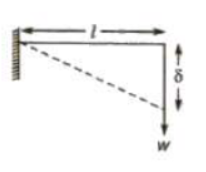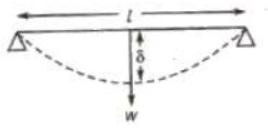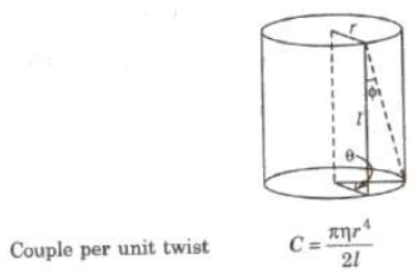Download CBSE Class 11 Physics Mechanical Properties Of Solids Notes Set B in PDF format. All Revision notes for Class 11 Physics have been designed as per the latest syllabus and updated chapters given in your textbook for Physics in Class 11. Our teachers have designed these concept notes for the benefit of Class 11 students. You should use these chapter wise notes for revision on daily basis. These study notes can also be used for learning each chapter and its important and difficult topics or revision just before your exams to help you get better scores in upcoming examinations, You can also use Printable notes for Class 11 Physics for faster revision of difficult topics and get higher rank. After reading these notes also refer to MCQ questions for Class 11 Physics given on studiestoday
Revision Notes for Class 11 Physics Chapter 8 Mechanical Properties of Solids
Class 11 Physics students should refer to the following concepts and notes for Chapter 8 Mechanical Properties of Solids in Class 11. These exam notes for Class 11 Physics will be very useful for upcoming class tests and examinations and help you to score good marks
Chapter 8 Mechanical Properties of Solids Notes Class 11 Physics
Deforming Force
A force which produces a change in configuration of the object on applying it, is called a deforming force.
Elasticity
Elasticity is that property of the object by virtue of which it regain its original configuration after the removal of the deforming force.
Perfectly Elastic Bodies
Those bodies which regain its original configuration immediately and completely after the removal of deforming force are called perfectly elastic bodies. e.g., quartz and phosphor bronze etc.
Perfectly Plastic Bodies
Those bodies which does not regain its original configuration at all on the removal of deforming force are called perfectly plastic bodies, e.g., putty, paraffin, wax etc.
Stress
The internal restoring force acting per unit area of a deformed body is called stress.
Stress = Restoring force / Area
Its unit is N/m2 or Pascal and dimensional formula is [ML-12T-2].
Stress is a tensor quantity.
Stress is of Two Types
(i) Normal Stress If deforming force is applied normal to the area, then the stress is called normal stress.
If there is an increase in length, then stress is called tensile stress.
If there is a decrease in length, then stress is called compression stress.
(ii) Tangential Stress If deforming force is applied tangentially, then the stress is called tangential stress.
Strain
The fractional change in configuration is called strain.
Strain = Change in the configuration / Original configuration
It has no unit and it is a dimensionless quantity.
According to the change in configuration, the strain is of three types
(1) Longitudinal strain= Change in length / Original length
(2) Volumetric strain = Change in volume / Original volume
(iii) Shearing strain = Angular displacement of the plane perpendicular to the fixed surface.
Hooke’s Law
Within the limit of elasticity, the stress is proportional to the strain.
Stress &infi; Strain
or Stress = E * Strain
where, E is the modulus of elasticity of the material of the body.
Types of Modulus of Elasticity
1. Young’s Modulus of Elasticity
It is defined as the ratio of normal stress to the longitudinal strain Within the elastic limit.
y = Normal stress / Longitudinal strain
y = FΔl / Al = Mg Δl / πr2l
Its unit is N/m2 or Pascal and its dimensional formula is [ML-1T-2].
2. Bulk Modulus of Elasticity
It is defined as the ratio of normal stress to the volumetric strain within the elastic limit.
K = Normal stress / Volumetric strain
K = FV / A ΔV = &DElta;p V / Δ V
where, Δp = F / A = Change in pressure.
Its unit is N/m2 or Pascal and its dimensional formula is [ML-1T-2].
3. Modulus of Rigidity (η)
It is defined as the ratio of tangential stress to the shearing strain, within the elastic limit.
η = Tangential stress / Shearing strain
Its urut is N/m2 or Pascal and its dimensional formula is [ML-1T-2].
Compressibility
Compressibility of a material is the reciprocal of its bulk modulus of elasticity.
Compressibility (C) = 1 / k
Its SI unit is N-1m2 and CGS unit is dyne-1 cm2.
Steel is more elastic than rubber. Solids are more elastic and gases are least elastic.
For liquids. modulus of rigidity is zero.
Young’s modulus (Y) and modulus of rigidity (η) are possessed by solid materials only.
Limit of Elasticity
The maximum value of deforming force for which elasticity is present in the body is called its limit of elasticity.
Breaking Stress
The minimum value of stress required to break a wire, is called breaking stress.
Breaking stress is fixed for a material but breaking force varies with area of cross-section of the wire.
Safety factor = Breaking stress / Working stress
Elastic Relaxation Time
The time delay in restoring the original configuration after removal of deforming force is called elastic relaxation time.
For quartz and phosphor bronze this time is negligible.
Elastic After Effect
The temporary delay in regaining the original configuration by the elastic body after the removal of deforming force, is called elastic after effect.
Elastic Fatigue
The property of an elastic body by virtue of which its behaviour becomes less elastic under the action of repeated alternating deforming force is called elastic fatigue.
Ductile Materials
The materials which show large plastic range beyond elastic limit are called ductile materials, e.g., copper, silver, iron, aluminum, etc.
Ductile materials are used for making springs and sheets.
Brittle Materials
The materials which show very small plastic range beyond elastic limit are called brittle materials, e.g., glass, cast iron, etc.
Elastomers
The materials for which strain produced is much larger than the stress applied, with in the limit of elasticity are called elastomers, e.g., rubber, the elastic tissue of aorta, the large vessel carrying blood from heart. etc.
Elastomers have no plastic range.
Elastic Potential Energy in a Stretched Wire
The work done in stretching a wire is stored in form of potential energy of the wire.
Potential energy U = Average force * Increase in length
= 1 / 2 FΔl
= 1 / 2 Stress * Strain * Volume of the wire
Elastic potential energy per unit volume
U = 1 / 2 * Stress * Strain
= 1 / 2 (Young’s modulus) * (Strain)2
Elastic potential energy of a stretched spring = 1 / 2 kx2
where, k = Force constant of spring and x = Change in length.
Thermal Stress
When temperature of a rod fixed at its both ends is changed, then the produced stress is called thermal stress.
Thermal stress = F / A = yαΔθ
where, α = coefficient of linear expansion of the material of the rod.
When temperature of a gas enclosed in a vessel is changed, then the thermal stress produced is equal to change in pressure (Δp)of the gas.
Thermal stress = Δ p = Ky Δ θ
where, K = bulk modulus of elasticity and
γ = coefficient of cubical expansion of the gas.
Interatomic force constant
K = Yro
where, ro = interatomic distance.
Poisson’s Ratio
When a deforming force is applied at the free end of a suspended wire of length 1 and radius R, then its length increases by dl but its radius decreases by dR. Now two types of strains are produced by a single force.
(i) Longitudinal strain = &DElta;U l
(ii) Lateral strain = – Δ R/ R
∴ Poisson’s Ratio (σ) = Lateral strain / Longitudinal strain = – Δ R/ R / ΔU l
The theoretical value of Poisson’s ratio lies between – 1 and 0.5. Its practical value lies between 0 and 0.5.
Relation Between Y, K, η and σ
(i) Y = 3K (1 – 2σ)
(ii) Y = 2 η ( 1 + σ)
(iii) σ = 3K – 2η / 2η + 6K
(iv) 9 / Y = 1 / K + 3 / η or Y = 9K η / η + 3K
Important Points
- Coefficient of elasticity depends upon the material, its temperature and purity but not on stress or strain.
- For the same material, the three coefficients of elasticity γ, η and K have different magnitudes.
- Isothermal elasticity of a gas ET = ρ where, ρ = pressure of the gas.
- Adiabatic elasticity of a gas Es = γρ
where, γ = Cp / Cv ratio of specific heats at constant pressure and at constant volume.
- Ratio between isothermal elasticity and adiabatic elasticity Es/ ET = γ = Cp / Cv
Cantilever
A beam clamped at one end and loaded at free end is called a cantilever.
Depression at the free end of a cantilever is given by

δ = wl3 / 3YIG
where, w = load, 1 = length of the cantilever,
y = Young’s modulus of elasticity, and IG = geometrical moment of inertia.
For a beam of rectangular cross-section having breadth b and thickness d.
IG = bd3 / 12
For a beam of circular cross-section area having radius r,
IG = π r4 / 4
Beam Supported at Two Ends and Loaded at the Middle

Depression at middle δ = wl3 / 48YIG
Torsion of a Cylinder

where, η = modulus of rigidity of the material of cylinder,
r = radius of cylinder, and 1 = length of cylinder,Work done in twisting the cylinder through an angle θ
W = 1 / 2 Cθ2
Relation between angle of twist (θ) and angle of shear (φ)
rθ = lφ or φ = r / l = θ
| CBSE Class 11 Physics Unit and Measurement Notes Set A |
| CBSE Class 11 Physics Unit and Measurement Notes Set B |
| CBSE Class 11 Physics Units And Measurements Notes |
| CBSE Class 11 Physics Motion In A Straight Line Notes Set A |
| CBSE Class 11 Physics Motion In A Straight Line Notes Set B |
| CBSE Class 11 Physics Motion In Plane Notes |
| CBSE Class 11 Physics Work Energy And Power Notes Set A |
| CBSE Class 11 Physics Work Energy And Power Notes Set B |
| CBSE Class 11 Physics Mechanical Properties Of Solids Notes Set A |
| CBSE Class 11 Physics Mechanical Properties Of Solids Notes Set B |
| CBSE Class 11 Physics Thermodynamics Notes Set A |
| CBSE Class 11 Physics Thermodynamics Notes Set B |
| CBSE Class 11 Physics Thermodynamics Notes Set C |
| CBSE Class 11 Physics Mathematical Tools Notes Set A |
| CBSE Class 11 Physics Mathematical Tools Notes Set B |
| CBSE Class 11 Physics Study Material All Chapters Set A |
| CBSE Class 11 Physics Study Material All Chapters Set B |
| CBSE Class 11 Physics Study Material All Chapters Set C |
| CBSE Class 11 Physics Physical World And Measurement Notes Set A |
| CBSE Class 11 Physics Physical World And Measurement Notes Set B |
CBSE Class 11 Physics Chapter 8 Mechanical Properties of Solids Notes
We hope you liked the above notes for topic Chapter 8 Mechanical Properties of Solids which has been designed as per the latest syllabus for Class 11 Physics released by CBSE. Students of Class 11 should download and practice the above notes for Class 11 Physics regularly. All revision notes have been designed for Physics by referring to the most important topics which the students should learn to get better marks in examinations. Our team of expert teachers have referred to the NCERT book for Class 11 Physics to design the Physics Class 11 notes. After reading the notes which have been developed as per the latest books also refer to the NCERT solutions for Class 11 Physics provided by our teachers. We have also provided a lot of MCQ questions for Class 11 Physics in the notes so that you can learn the concepts and also solve questions relating to the topics. We have also provided a lot of Worksheets for Class 11 Physics which you can use to further make yourself stronger in Physics.
You can download notes for Class 11 Physics Chapter 8 Mechanical Properties of Solids for latest academic session from StudiesToday.com
Yes, the notes issued for Class 11 Physics Chapter 8 Mechanical Properties of Solids have been made available here for latest CBSE session
There is no charge for the notes for CBSE Class 11 Physics Chapter 8 Mechanical Properties of Solids, you can download everything free of charge
www.studiestoday.com is the best website from which you can download latest notes for Chapter 8 Mechanical Properties of Solids Physics Class 11
Come to StudiesToday.com to get best quality topic wise notes for Class 11 Physics Chapter 8 Mechanical Properties of Solids

